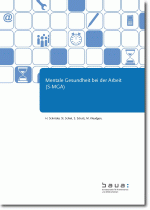A new method of calculation on the basis of two factors
The WAI was developed in the 1980s by the Finnish Institute of Occupational Health in the absence of a suitable instrument to subjectively measure ability to work. The instrument was originally applied to conduct research on gradual retirement age in different occupational groups. Work ability is defined as a person's potential to manage his/her work, taking into account the person's mental and physical resources.
The WAI questionnaire is freely available. It can be used as a self-report screening instrument for employees or in dialogue with the occupational physician, as well as for scientific research on work ability.
In the WAI, seven indicators are assessed on the basis of 10 questions. In the past, these indicators were added up to form a total index with values between 7 and 49 points:
- (WAI 1) Current work ability compared with the lifetime best
- (WAI 2) Work ability in relation to the demands of the job
- (WAI 3) Number of diseases diagnosed by a physician
- (WAI 4) estimated work impairment due to diseases
- (WAI 5) Sick leave during the past year (12 months)
- (WAI 6) Own prognosis of work ability two years from now
- (WAI 7) Mental resources
However, several recent studies on the psychometric structure of the WAI have shown that the assumed one-dimensionality cannot be supported. Consequently, the majority of international studies concludes that the WAI is based on two factors. For Germany, the results from the representative "Study on mental health at work (S-MGA)" also identified two factors for the WAI:
- Subjective work ability and resources based on the indicators (WAI 1), (WAI 2), (WAI 6) and (WAI 7)
- Health-related factor based on the indicators (WAI 3), (WAI 4) and (WAI 5)
These results call a summation of the indicators of the WAI to a total index into question. It has furthermore been demonstrated that the seven WAI indicators have a varying degree of influence on work ability.
For these reasons, a new calculation method for the weighted determination of two WAI factors was developed at BAuA. Furthermore, current standard value tables for both factors - separated by gender and age group (31–40, 41–50 and 51–60 years) - based on data of the working population in Germany are presented.
To ease the application of the new method at the practical level, a calculation tool is available here.

